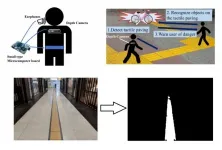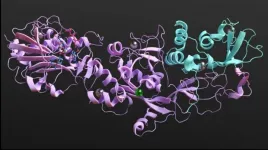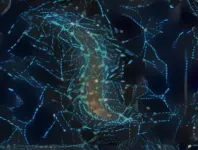(Press-News.org) CHICAGO -- Immunotherapy, which recruits the body's own immune system to attack cancer, has given many cancer patients a new avenue to treat the disease.
But many cancer immunotherapy treatments can be expensive, have devastating side effects, and only work in a fraction of patients.
Researchers at the Pritzker School of Molecular Engineering at the University of Chicago have developed a new therapeutic vaccine that uses a patient's own tumor cells to train their immune system to find and kill cancer.
The vaccine, which is injected into the skin just like a traditional vaccine, stopped melanoma tumor growth in mouse models. It even worked long-term, destroying new tumors long after the therapy was given.
The results were published March 24 in the journal Science Advances.
"This is a new strategy for immunotherapy," said Prof. Melody Swartz, who led the research. "It has the potential to be more efficacious, less expensive and much safer than many other immunotherapies. It is truly personalized medicine that has the potential to overcome many issues that arise with other treatments."
Recruiting a broad immune response
In many ways, the vaccine works like a traditional flu vaccine: it uses a less-potent version of the pathogen (here, a patient's own cancer cells, which are lethally irradiated before injection) to train the immune system to fight the disease.
However, rather than a preventive measure, this is a therapeutic vaccine, meaning it activates the immune system to destroy cancer cells anywhere in the body. To create it, Swartz and her team used melanoma cells from mice and then engineered them to secrete vascular endothelial growth factor C (VEGF-C).
VEGF-C causes tumors to strongly associate with the body's lymphatic system, which is normally considered bad for the patient, since it can promote metastasis. But the team recently found that when tumors activate surrounding lymphatic vessels, they are much more responsive to immunotherapy and promote "bystander" T cell activation, leading to a more robust and long-lasting immune response.
The team then had to figure out how to harness the benefits of lymphatic activation in a therapeutic strategy while avoiding the potential risks of metastasis.
'Training' the immune system
Maria Stella Sasso, a postdoctoral fellow and first author of the paper, tested many different strategies before settling on the vaccine approach, which allowed immune "training" in a site distant from the actual tumor.
The strategy of using a patient's own irradiated tumor cells in a therapeutic vaccine had previously been established by Glenn Dranoff and colleagues at the Novartis Institutes for BioMedical Research, who developed GVAX, a cancer vaccine that has been shown safe in clinical trials. Sasso decided to try this approach with VEGF-C rather than the cytokine used in GVAX. She dubbed the strategy "VEGFC-vax."
After engineering the cells to express VEGF-C, the research team irradiated them, so they would die within a few weeks. When they injected the cells back into the skin of mice, they found that the dying tumor cells could attract and activate the immune cells, which then could recognize and kill the actual tumor cells growing on the opposite side of the mouse. Since each tumor has its own unique signature of hundreds of molecules that the immune system can recognize, the vaccine promoted a broad, robust immune response.
That led to the prevention of tumor growth in all of the mice. It also led to immunological memory, preventing new tumor growth when tumor cells were re-introduced 10 months later.
"This shows that the therapy may provide long-term efficacy against metastasis and relapse," said Swartz, William B. Ogden Professor of Molecular Engineering.
Potential therapy for many types of cancers
Conceptually, this is the first strategy to exploit the benefits of local lymphatic vessel activation for more robust and specific immune response against tumor cells.
Unlike immunotherapeutic strategies that stimulate the immune system in a general way, such as checkpoint blockade or the many cytokines currently in preclinical development, this new immunotherapy activates only tumor-specific immune cells. Theoretically, this would avoid common side effects of immune stimulants, including immunotoxicity and even death.
And while many other cancer immunotherapies, such as CAR-T cell therapy, are tumor-specific, these strategies only work against tumor cells that express specific pre-identified tumor markers called antigens. Cancer cells can eventually overcome such treatments by shedding these markers or mutating, for example.
VEGFC-vax, however, can train immune cells to recognize a large number and variety of tumor-specific antigens. More importantly, these antigens do not need to be identified ahead of time.
The researchers are working to test this strategy on breast and colon cancers and think it could theoretically work on any type of cancer. They hope to ultimately take this therapy to clinical trials.
"We think this has huge promise for the future of personalized cancer immunotherapy," Swartz said.
INFORMATION:
Citation: "Lymphangiogenesis-inducing vaccines elicit potent and long-lasting T cell immunity against melanomas," Sasso et. al, Science Advances, Mar. 24
Funding: National Cancer Institute R01 CA219304
The University of Chicago is a leading academic and research institution that has driven new ways of thinking since its founding in 1890. As an intellectual destination, the University draws scholars and students from around the world to its campuses and centers around the globe. The University provides a distinctive educational experience and research environment, empowering individuals to challenge conventional thinking and pursue field-defining research that produces new understanding and breakthroughs with global impact.
Addressing uncertainties about where large earthquakes are most likely to occur along the southern San Andreas fault, which splits into multiple strands east of Los Angeles, a new study identifies a strand that has largely flown under the radar of public concern as the region's greatest earthquake threat. The study determines that the Mission Creek strand, which passes through major water and power infrastructure for the greater Los Angeles region, may account for almost the entire slip rate of this portion of the fault, suggesting it may actually be the primary Pacific-North American plate boundary fault at this latitude. The San Andreas fault threatens large future earthquakes, since its southernmost section has not ruptured in almost 300 years ...
A 12-centimetre-thick sample of a deposit from a cave in the northeast of Greenland offers unique insights into the High Arctic's climate more than 500,000 years ago. The geologist and cave scientist Prof. Gina Moseley collected it during an exploratory expedition in 2015 for her palaeoclimatic research in one of the most sensitive areas of the world to climate change. The cave is located at 80° North 35 km from the coast and 60 km from the Greenland Ice Sheet margin. It was part of the Greenland Caves Project, funded by 59 different sponsors including the National Geographic Society. Moseley and her team are interested in the climate and environmental history captured by the unique cave deposit. "Mineral deposits formed ...
A study of 49 patients reveals that toxins from the bacterial pathogen Staphylococcus aureus can destroy the body's blood-clotting platelets, raising the risk of death during bacterial blood infections. Further experiments in mice also showed that the approved drugs ticagrelor and oseltamivir protected platelets and helped treat infections, suggesting these compounds could be repurposed into badly needed therapies for blood infections. Bacterial blood infections have mortality rates as high as 20% to 30% even with supportive care, and these rates have remained high for decades. Blood infections can also cause complications such as sepsis and endocarditis, and the rise of multidrug resistance has only compounded what was already a serious ...
Immunotherapy, which recruits the body's own immune system to attack cancer, has given many cancer patients a new avenue to treat the disease.
But many cancer immunotherapy treatments can be expensive, have devastating side effects, and only work in a fraction of patients.
Researchers at the Pritzker School of Molecular Engineering at the University of Chicago have developed a new therapeutic vaccine that uses a patient's own tumor cells to train their immune system to find and kill cancer.
The vaccine, which is injected into the skin just like a traditional vaccine, stopped melanoma tumor growth in mouse models. It even worked long-term, destroying new tumors long after the therapy was given.
The results were published ...
Eating just one cup of leafy green vegetables every day could boost muscle function, according to new Edith Cowan University (ECU) research.
The study, published today in the Journal of Nutrition, found that people who consumed a nitrate-rich diet, predominantly from vegetables, had significantly better muscle function of their lower limb.
Poor muscle function is linked to greater risk of falls and fractures and is considered a key indicator of general health and wellbeing.
Researchers examined data from 3,759 Australians taking part in Melbourne's Baker Heart and Diabetes Institute AusDiab study over a 12-year ...
Sight is by far the sense that we humans use the most when navigating an environment. When those who are blind or visually impaired walk alone, they put themselves at great risk of falling or colliding with obstacles, especially when traversing new places. Unfortunately, the number of visually impaired people throughout the world is likely to increase in the near future because of the rapidly aging population. Thus, there is an urgent need for innovative and cost-effective solutions to help visually impaired people navigate safely.
A promising strategy that was first implemented in Japan and then replicated throughout the world is called tactile paving. Inspired by Braille, the reading system of the blind, tactile paving essentially consists of ...
When invaded by a virus, our body cells launch an alert to neighboring cells to increase their antiviral defenses to prevent the infection from spreading. Some viruses, however, manage to bypass this system by mimicking the host's RNA, preventing them from being detected by the infected cell and avoiding this alert. In the case of SARS-CoV-2, this mimicking uses a protein known as nsp14. This protein is also very important for virus multiplication, a task which is facilitated by its binding to the nsp10 protein, resulting in a protein complex. Interfering with nsp14 binding and with the nsp10-nsp14 protein complex is the aim of the most recent ITQB NOVA research in COVID-19, led by researchers Margarida Saramago, Rute Matos and Cecília Arraiano.
The researchers ...
Researchers find that the earliest bacteria had the tools to perform a crucial step in photosynthesis, changing how we think life evolved on Earth.
The finding also challenges expectations for how life might have evolved on other planets. The evolution of photosynthesis that produces oxygen is thought to be the key factor in the eventual emergence of complex life. This was thought to take several billion years to evolve, but if in fact the earliest life could do it, then other planets may have evolved complex life much earlier than previously thought.
The ...
Beams of accelerated electrons power electron microscopes, X-ray lasers, medical accelerators and other devices. To optimize the performance of these applications, operators must be able to analyze the quality of the beams and adjust them as needed.
For the past few years, researchers at the Department of Energy's SLAC National Accelerator Laboratory have been developing "virtual diagnostics" that use machine learning to obtain crucial information about beam quality in an efficient, non-invasive way. Now, a new virtual diagnostic approach, published in Scientific Reports, incorporates additional information about the beam that allows the method to work in situations where conventional ...
Despite aquaculture's potential to feed a growing world population while relieving pressure on badly depleted oceans, the industry has been plagued by questions about its environmental impacts. (Watch related video: https://www.youtube.com/watch?v=DG_nl7-naYo)
But over the years, the diverse industry - which ranges from massive open-ocean salmon cages to family farm freshwater tilapia ponds - has made significant strides toward sustainability, according to a new Stanford-led analysis.
The study notes, however, that in order for the global aquaculture sector to deliver on its full promise, more effective oversight measures are ...





